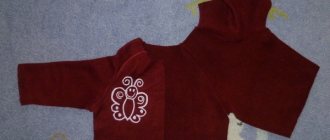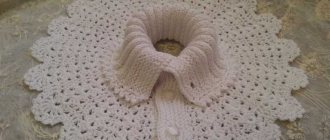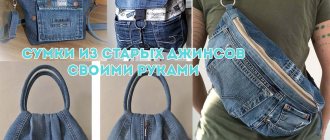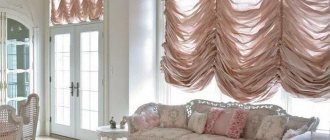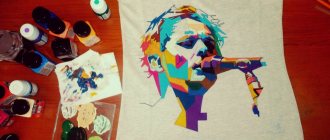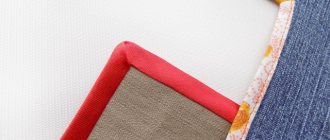We sew a sofa cover with our own hands
A sofa cover is a useful and convenient element that will help breathe life into old furniture and preserve new ones, especially if the standard upholstery of the sofa is not very wear-resistant. By creating a cover you can change the design of your apartment, decorate the interior, and highlight individual details. At the same time, there is no need to buy expensive materials and accessories or order a cover, spending a lot of money on it. You can easily make your own cover for an old kitchen, a children's sofa, or furniture for a living room or bedroom. This could be a leather cover or a fabric sofa - it all depends on your tastes, preferences and what kind of furniture you prefer to use.
How to sew a sofa cover yourself?
In order to make a sofa cover yourself, it is enough to use the skills of working with a sewing thread and a needle. A sewing machine will be an excellent assistant. But most of the work still needs to be done manually. Pattern making skills will also come in handy. After all, you need to make it yourself individually for your sofa.
But here you can cheat. A very simple and easy way is to use an old cape that may have been lying around in the closet. It must be cut into separate pieces and transferred to new material.
An old cape can be found in almost every home. Fortunately, there are many master classes on the Internet that offer various methods and options on how to properly make a sofa cover. They provide step-by-step instructions that will simplify the creation of the pattern.
Making a cover for a corner sofa with your own hands
The most difficult thing is to sew a cover for a corner sofa with your own hands. Before cutting, the fabric must be thoroughly washed, dried and ironed. This is done in order to provide for possible shrinkage of the product.
The cover must be created in separate parts. This cover can be made for a classic sofa. It will appeal to people who value comfort and practicality. There are several options here:
- Attached corner section. You need to sew five covers with a reinforced seam: on the main part of the sofa, the side part, the armrests and the back.
- Insertable corner section or solid corner structure. In this case, the covers are made separately on the corner of the sofa and the covers are worn together from the inside out. The most important thing here is to hide the seams between the corner and the wings. After all, they will be located on the seat and back. Pleated fabrics will help with this perfectly. But this is quite difficult to do. Fabricated pleated material is also quite difficult to work with. There is an alternative - choose a fabric in a different color so that the seam on it is invisible.
Our advice: an easy way to hide a front seam. This can be done by inserting it by tightening the fabric. If you decide to sew a cover from a coarse and dense material (for example, canvas in a rustic style), then all seams should be seams. They can be made using a sewing machine.
What fabric should I use to make a sofa cover?
It is worth taking the choice of fabric seriously. Any type of material will work the first time. For anyone, a sofa cover should be practical and durable.
It is not recommended to use two extremes - too heavy and dense upholstery fabric, which is used for the manufacture of upholstered furniture, too light, does not hold its shape well, and thin, which requires additional processing.
Lightweight fabrics include chiffon, rayon and satin. Capes made from these fabrics look incredibly beautiful, but they will not last long and will quickly lose their attractive appearance. It is still better to use such materials for sewing clothes and accessories.
Many people believe that upholstery fabric will be an ideal option for sewing a cover, because it is used to create sofas, armchairs and corners. But please note that the upholstery is tightly fastened to the frame using a stapler and small nails. This means that such material is completely inelastic. You simply cannot physically tighten its back and armrests. Who should not forget that the cover must be removed periodically in order to wash it.
That is why it is best to choose the golden mean - moderately dense, moderately soft and elastic material. Ideally, it should be impregnated with a special product. Waterproof material will allow the furniture to remain fresh and clean for a long time.
If you don’t want to specifically buy fabric to make a cover, you can use improvised materials. We present the options for what material the cape can be made from:
- eco-leather;
- izplad;
- from the bedspread;
- from jeans and many other things.
With a little effort and imagination, you can even make a beautiful sofa cover out of old clothes.
The sofa cover can be decorated in various ways. The lower part can be ruffled. Embroidered ribbon will also look beautiful. A cape created in patchwork style will look interesting. To create it you will need scraps of a wide variety of fabric.
What fabric to choose for sewing a sofa bedspread?
Where to start sewing a blanket? First of all, you should decide on the fabric from which the bedspread will be made. When choosing a material, you need to pay attention to its performance characteristics: wear resistance, moisture resistance, density, tactile qualities and appearance. What parameters should you use to choose fabric for a bedspread on a sofa?
Functions of the bedspread
The bedspread performs not only an aesthetic function, although appearance plays an important role when choosing material. A furniture cover or blanket is needed to:
- protect furniture upholstery from dirt and damage;
- warm in the cool season;
- cover defects, such as worn upholstery.
If the bedspread will perform only an aesthetic function, then you can choose a light flowing satin as a material, which will fit perfectly into a classical-style interior. If the sofa cover will also be used as a blanket, then it is better to opt for dense and warm fabrics - wool, microfiber, faux fur.
Frequency of use of a piece of furniture
Materials such as tapestry and jacquard have proven themselves best in terms of wear resistance. They are dense, strong, and do not wear out over a long service life. Curtain fabric also works well. Curtains and covers made from the same fabric will look great in the living room.
Color plays an important role when choosing fabric. Products in light colors look good in small rooms, living rooms, and children's rooms. However, it is worth considering that such covers will have to be washed frequently. If the blanket is used often, it is better to choose dark, non-staining colors: brown, burgundy.
Presence of small children and animals in the house
If there are children in the house, the fabric for the cover should be durable, waterproof and hypoallergenic. Jacquard, wool and fur are not suitable for a children's room because they accumulate a lot of dust, which can cause allergies in a small child. The best choice is microfiber or acrylic. These synthetic fabrics are hypoallergenic and easy to wash in a washing machine, which is especially important in a home with small children.
Pet owners know that sometimes their pets like to sharpen their claws on a furniture cover or chew on it. That is why you should buy a flock or microfiber blanket for a house with a cat or dog, which does not leave claw marks.
Making a rubber sofa cover with your own hands
The rubber fastening is incredibly convenient. It is used to make mattress covers and bed linen. This technology can be used to create furniture covers.
Initially, you need to sew the cape itself. Then you need to sew a rubber band into the bottom part. It will keep the cover in place in any situation, even when several people are sitting on the sofa.
Another advantage of this method is that the finished cape can not only be easily put on the sofa, but also removed from the snow. It is convenient for washing and cleaning.
In addition to the elastic, various other fasteners can be used. The cover with a lock is also incredibly convenient—it allows you to remove the sofa cover in just a few seconds. A simple universal tension cover is popularly called “Eurocover”. It can have many design options that never cease to amaze.
How to make a sofa cover with your own hands without sewing?
It is not necessary to make a namebel cape using sewing. There are other ways to create it. For example, a cover can be made from a single piece of fabric.
In addition, the cover can be knitted on the inside. This can be done from scratch. Or you can use old sweaters for this. This decorative element will look very beautiful in a room designed in a rustic or Provence style. It will add comfort and warmth.
How to sew a corner of a sofa cover?
If you have purchased upholstered furniture with expensive and beautiful upholstery, it is clear that you do not want to hide it under various blankets and blankets. Nezyryazhe spent hours choosing the shade of upholstery and texture that matched the pile of the carpet and curtains!
In such cases, you want to protect only the most sensitive and most dirty parts. You can easily make separate covers for the armrests, pillow, sides or seat. In addition, you can make compact pockets for remote controls, which is very practical and convenient.
If a common cover holds all parts of the sofa cover, then the armrests can fly off very quickly. When creating them, it is necessary to consider an autonomous mount. Linens, elastic bands or ribbons, bows or laces are perfect. They will look beautiful. You can also use snaps or Velcro. But it is better to sew them on the bottom of the armrest so that they do not interfere. Otherwise, you will have to change them often or they will ruin your clothes.
This is very convenient, because you can make several capes at once. They are easy to change when washing, and they will also help update the design of the sofa and make it more interesting when it starts to wear out. They can be matched to pillowcases, pillows or other elements of the room.
We sew a simple sofa cover with our own hands
If you know how to sew at least a little, you can sew a sofa cover with your own hands. You don't even need a pattern for this. It would be useful to make such a case for novice crafters to develop their skills.
Sewing a sofa cover with your own hands
Materials and tools
- Textile
- Pins
- Measuring tape
- Threads
- Sewing machine
- Sharp scissors
- Fabric pencil
Step 1
Before sewing a cover for a sofa, you must first measure it. Divide the sofa into sections. Even if the upholstered furniture has non-standard dimensions, cut all parts in a rectangular shape.
Measure the seat, backrest, two armrests and two pads for the front of the armrests. You will end up with six rectangular templates.
Step 2
Remember to measure each part of the sofa as a rectangle, regardless of its actual shape.
Write down your measurements and add 7.5cm to all sides of each rectangle to ensure adequate seam allowances.
Step 3
Armrest insert, one for each
Draw an exact drawing of all the rectangles on paper, adding an extra 7.5 cm. Cut them out.
You can use either light upholstery material (137-152 cm wide) or a couple of large pieces.
Step 4
Wrong side out
Pre-treat your chosen fabric. Wash it in cold water and dry it. Place on a flat surface.
Using your measurements, cut out 6 rectangular pieces. Start from the back. Once all the pieces are cut out, place them wrong side down on the appropriate sections of furniture.
Use pins to pin pieces of fabric to the furniture to prevent them from slipping.
Step 5
Pin the armrest insert
Pin the pieces of fabric together; then sweep them away without removing them. For basting, use a thread of a contrasting color.
In order for the product to follow the shape of the furniture, you need to take into account all the angles and bends when connecting pieces of material with pins.
Step 6
Trim excess fabric
Remove the pinned fabric from the sofa. Sew all seams using a sewing machine at a distance of 2.5 cm from the basting line. Turn right side out and place on the sofa.
Look carefully at the places where the cover may not fit well, and make additional marks in these places. Turn inside out again. Sew the cover again, taking into account the additional changes made. Trim any excess fabric.
Making a cape cover
The simplest option to achieve what you want is to make a continuous “bedspread” for the sofa. The parts are cut out and then put together into a single whole. For the “sofa cover” operation you need to prepare:
- textile;
- centimeter;
- ruler;
- chalk;
- tailor's scissors;
- tracing paper, graph paper, newspapers or unnecessary wallpaper;
- pins or needles;
- threads: ordinary for basting, lavsan - for a sewing machine.
Material calculation, pattern
Task #1 is determining the amount of fabric. Before you go to the store to buy it, you need to carry out this operation. If the sofa has standard dimensions, then the cover will require approximately 8 m of fabric. For a more accurate calculation, measure the length and width of the furniture, multiply each figure by 2 and add it up.
Further calculation assumes a standard fabric width of 1.5 meters. If the sofa has a length of 210 cm and a width of 180 cm, then 7.8 m of material will be required. However, this is only an approximate guideline that requires final adjustment, so before going to the store you need to make a full-fledged pattern.
For it, the dimensions are written down on paper and the shapes of all areas and the smallest details are drawn on a small scale. Then they are transferred to life-size paper (or newspapers or wallpaper glued together). Leave allowances for seams, hems, 7 cm - the required minimum for covers. After receiving large parts, they are applied to the sofa and all dimensions are checked.
Fabric consumption will increase significantly if the choice falls on a material with a pattern that requires matching at the seams. In any case, it is recommended to add another one to one and a half meters to the resulting figure. In this case, it is easier not to get into trouble, and the remaining material will be useful for replacing worn-out areas of the cover, adding frills, ruffles, and pillowcases to decorative pillows. If there is still not enough fabric, then it is “stolen” from the back of the back, for which another fabric can be used.
The process of cutting fabric, sewing
When all the elements of the pattern fit perfectly, begin cutting the pre-prepared fabric. Woolen and cotton material is washed in warm water in advance so that it shrinks, otherwise the cover may simply not fit on the sofa after washing. Ironing through damp gauze is mandatory for any fabric.
It is placed face down on a flat, hard surface. Taking into account the direction of the grain thread, the patterns are laid out on the fabric and secured with needles or pins. They are drawn along the contour with chalk, and a second line is drawn at a distance of 7 cm from the first line. The material is cut out from it.
The resulting parts are folded with the wrong side out, a basting is made, then fitting on furniture follows. If there are no defects, the allowances are reduced to 3 cm, the seams are ground down, the edges are folded, basted, and after a new fitting they are stitched.
Covers for corner sofa
For sewing, covers for corner furniture work in a similar way, in which the most important thing is a correctly made pattern. There is only one difference: first, two parts are sewn separately, then they are joined together. Each seam from the inside is treated with non-woven tape; this additional work will help the sofa cover of a complex shape to hold it. The fabric is secured at the corner joints, otherwise the product will look like a carelessly thrown cape.
A witty way
This is the simplest option and allows you to get the case very quickly. For it, they take a fairly large piece of elastic fabric, with which the sofa is completely covered. The hanging parts are trimmed from below or the furniture is turned over and the excess is pulled off at the bottom. Excess fabric on the armrests is eliminated with draperies. To avoid displacement of the cover, wooden slats or pieces of metal-plastic pipe are inserted between the seat and other parts.
Master class on how to pattern a bedspread for a corner sofa with your own hands
If there are small children or pets in the house, then the owner of the living room - the sofa - will require additional protection. The best way to ensure this is to purchase a bedspread or cover for the sofa. If you have experience in sewing or a great desire to try to make something with your own hands, then why not sew a case yourself? Such a product will be able to add a unique decoration to the interior of the living room, and will also provide the room with an atmosphere of home comfort. In this article we will tell you how to sew a bedspread on a corner sofa with your own hands.
Design and shape
To make a cut, you need to decide on the model and shape. There are several basic options. The shape of the parts can be angular or rounded. As for the model, it is important to take into account the type of sofa itself - corner, round, long, square.
Shape and design
There may be fasteners in the form of ties, elastic bands, buttons, or zippers. Additionally, you can sew on ruffles, frills, inserts and frills.
Do you need a blanket?
The main reason for using a bedspread is to protect the upholstery of the sofa. After all, even if it is made of fabric that is stain-resistant and easy to clean, stains from markers planted by children and pet hair cannot be avoided.
The bedspread is usually made of fabric that has a high level of density, good wear resistance and flexibility in washing. This material can protect upholstery fabric from stains, traces of spilled drinks, children's art, animal claws, stuck candy and chewing gum, and much more.
Additionally, if your sofa's upholstery is made of leather or faux leather, while it may look luxurious, it may feel cold to the touch. In the summer this is only beneficial, but on cold winter or damp autumn evenings, when frost runs through the skin even from the mere thought of a walk, such upholstery can create a feeling of discomfort. To prevent it from appearing, “winter clothes” made of a warm, fleecy blanket are put on the sofa.
We all have a desire for a change of scenery at some point. Old furniture is no longer pleasing to the eye and you want something new. A beautiful case will save this situation. You can make several of them and change them depending on your mood or the seasons. But it’s worth remembering that if you use the sofa every day as a sleeping place, then constantly taking off and putting on the cover will be simply tiresome. In this case, it is better to use a blanket.
If your sofa has a modular design and you like to rearrange it sometimes, then the cover should be of different sizes and placed on each component part.
Why is it better to sew a bedspread yourself?
It is best to sew a thing with such functionality yourself. There are several good reasons for this:
- You can choose individual dimensions and shapes.
- Any material can be used.
- Any type of material can be used as finishing.
- The color of the item depends on personal preference.
- It is easy to choose an individual product design.
Design
In addition, the item will be of high quality and will definitely last for many years.
How to sew a cover for a corner sofa
Due to the rather large dimensions of the sofa, it is recommended to sew the cover in separate parts. To work you will need:
- fabric (choose one that is easy to care for and durable);
- threads matching the color of the main material;
- sewing machine;
- pins;
- pattern paper
- chalk, pencil or piece of soap;
- scissors.
First, we take measurements of each part of the sofa. We transfer everything that we measured onto the pattern paper, leaving two to three centimeters for the seams. Cut out the pattern and trace it onto the fabric. Use a sewing machine to sew the cut parts together. Now all that remains is to iron the cover and try it on the sofa. If you didn’t succeed the first time, then try to change the cover again and you will certainly succeed.
Necessary equipment
The set of tools depends on the design of the product and the type of fabric. The standard set of sewing accessories will be the following tools:
- Scissors or textile knife.
- Chalk, measuring tape.
- Awl, thread, needle, safety pins.
- An elastic band, tape or lace to secure some parts.
- Sewing machine for forming basic seams.
- Iron for smoothing seams.
You might be interested in Simple ready-made patterns and sewing a sweater with your own hands
Tools
Depending on the model and special manufacturing conditions, other tools and devices may be used.
How to sew a bedspread for a corner sofa
To begin with, we would like to recommend trying your hand at sewing a test bedspread from an old sheet or making a small blanket for an armchair or children's sofa. This will help you understand the whole process and not repeat the mistakes you made next time. Also, using unnecessary fabric for a trial version will prevent you from ruining the new one.
Let's start taking measurements. This process is of great importance, because if you make a mistake, the end result will look ridiculous and you are unlikely to like it. Start by measuring the length of the entire sofa, then the corner section. Finally, measure the width of the seat. Remember, if the corner and main parts of the seat are different widths, be sure to take this into account in your measurements. Now you need to add three to five centimeters, which will go towards allowances.
If you want to make a bedspread with a frill, you should measure the distance from the seat to the floor. Don't make the frill too long. Up to six centimeters from the floor will be enough. Otherwise it will quickly become dirty. Next, let's move on to creating a pattern.
Material selection
Not every type of fabric will be suitable as a bedspread. The material must be dense and resistant to wear, because it will have to be washed quite often. It should also be easy to care for. Contaminants should not be absorbed. But at the same time, the material must have an attractive appearance and be pleasant to the touch.
For this we recommend:
- faux fur - can decorate various types of interiors, especially ethnic and modern, this material is easy to wash and quick to dry, a faux fur blanket will warm you well and add a cozy atmosphere;
- tapestry - a beautiful fabric, often decorated with decorative patterns, is particularly strong and durable, wear-resistant and dense material;
- velvet – has a very attractive, expensive appearance, the fabric is soft and pleasant to the touch, but is not very wear-resistant;
- microfiber is a synthetic material. which has a high level of hygroscopicity, provides good protection against various stains, is good and easy to wash, but can cause an allergic reaction and should not be dried near heating appliances;
- velor - looks like velvet, but differs from it in greater wear resistance, looks beautiful as a bedspread, has a warming effect, and is a fairly durable material;
- plush - this type of fabric is often used for making blankets; it is warm and pleasant to the touch, easy to care for and dry quickly.
If this is your first sewing experience, it is recommended to use a plain fabric, otherwise there may be problems with matching patterns in the seam area.
Types of furniture covers
However, buying a ready-made cover is not so easy, even if the furniture owners are not limited by budget. And all because it is extremely difficult to choose an accessory that is ideal for a specific model. An exception is ordinary capes, but they are less practical and convenient to use, since a rectangular piece of fabric will not be able to cover the entire sofa and will constantly slide off its surface.
Fabric covers
There is another option to get the coveted case, which consists of individual tailoring to order. However, it also has one significant drawback, which is the considerable costs of materials and their processing. In addition, it is far from a fact that the studio will do their job quickly and efficiently, because sewing a continuous cape requires constant adjustment, which is almost impossible to ensure if there is no furniture nearby.
That is why it is much easier to sew a Euro-cover for a sofa with your own hands, constantly taking measurements from it and applying the cut parts to the furniture, which is very convenient and useful for a successful result. Don’t be afraid of the complexity of this process, because there are several easy ways to sew a sofa cover that even a novice craftswoman can do.
Before you start cutting and sewing, you should think about what exactly your dream bedspread should turn out to be, because the harmony of the entire interior depends on this detail. Currently, the most popular models are:
- One-piece case without fasteners. As a rule, such models completely replicate the furniture silhouette with a small margin, so they are quite easy to take off and put on. At the same time, they “sit” firmly on the furniture, without sliding off it after someone sits down or stands up, which is very convenient. As for the design, such cases can have not only a strict geometric silhouette, but also a flirty frill around the entire perimeter. Usually the first option is made from dense simple fabrics such as coarse linen or cotton, opting for plain fabrics in light pastel colors. But for the second model, it is better to choose a colorful fabric with a floral print, which is ideal for interiors designed in the style of shabby chic and Provence. In addition, you can sew stronger and more durable, but no less elegant, covers from thick tapestry fabric, which is a good old classic that goes well with natural wood, baroque ornate patterns and crystal chandeliers. If you need to make a child’s pattern for a chair cover with your own hands, then you should take a closer look at the easy and simple patchwork technique made from colorful scraps taken from different fabric cuts.
- If you don’t want to bother with frills and straight floor-length silhouettes that are quickly trampled by guests, then you can make your own sofa cover with an elastic band that ensures a rigid fixation of its edge under the seat. The principle of sewing the upper part of such an accessory is no different from the model described, while its bottom is made shorter with folds in the corners or along the entire perimeter, necessary to thread a wide elastic band. If desired, you can replace the elastic with fabric or twisted ribbons, using the hem as a drawstring.
- There is another option for sewing a sofa cover, the peculiarity of which is the use of special rubberized fabrics over the entire area. This material is quite dense, but at the same time it stretches very well, completely hugging the surface of upholstered furniture. The only drawback of rubber covers is that they require additional fixation in the area of furniture seams, which is not always possible to provide. There are two ways to solve the problem, the first of which involves making each element separately (seat, back, armrests) without further joining them into a common fabric, while the second involves abandoning the sewing of rubber bedspreads in favor of models made from ordinary non-stretch fabrics with a rubberized edge or a frill at the bottom.
The most popular fabrics for permanent or removable furniture upholstery are velvet (velor), natural suede, tapestry, plain and Teflon flock, cotton (cotton), microfiber, jacquard and chenille.
When using a combination of different fabrics for sewing patchwork bedspreads, it is recommended to choose those materials that will have approximately the same density and thickness, otherwise the finished product will very quickly become unusable, stretching or even losing its integrity in certain places.
Knitted blankets
Perhaps the most stylish removable covering for upholstered furniture today are handmade knitted bedspreads. Such blankets turn out to be very delicate, fitting perfectly into the interior of bedrooms and children's rooms, and it is on a knitted cover that it is most comfortable to drink coffee with milk, play with a child, read colorful books or just hug.
The most commonly used models are the following, which you can easily make yourself:
- Fine knit jacquard blankets. These bedspreads are suitable for cribs and chairs, as they are made from thin yarn. Most often, capes are made in light pastel colors, making them monochromatic, although it is quite acceptable to combine two or more contrasting shades. Checkerboard blankets look very cool, divided into separate sectors, each of which is knitted using different techniques (one square with stockinette stitch, the second with garter stitch, the third with aran stitch, etc.) or filled with delicate monochromatic or colored jacquard patterns (bunnies, snowflakes, hearts , starfish, etc.).
- For stylish loft, minimalism and hi-tech interiors, voluminous capes are made from the thickest cotton yarn. This pleasure is not the cheapest, so it is better to buy threads and knit such a blanket yourself, especially since due to the thickness of the material, the work time is reduced to several days. Most often, for knitting bedspreads from the thickest yarn, stockinette or garter stitch is used. The finished product looks both catchy and gentle, suitable for both a woman’s bedroom, decorated in light colors, and a brutal bachelor’s apartment. In this case, you need to knit from thick yarn either with giant wooden knitting needles or by hand, using the same technique as for crochet, only pulling out each new loop by hand.
The undoubted advantage of knitted blankets compared to sewn ones is that they are much easier to adjust to furniture, and this is especially true when it comes to models such as click-clack (a sofa that transforms into a bed and vice versa) or solsta with its rectilinear geometric forms. In addition, the product can always be remade by undoing the row in which the mistake was made. As for the disadvantages, the main one is the washing properties of the blanket, because knitted items tend to shrink, stretch and dry for a long time, often “suffocating” after hand washing and a weak spin.
We cut and sew
Let's start by cutting out the top part of the material. Don't forget to allow allowances of three to five centimeters. It is better to let them be larger than smaller, because cutting off excess material is not a problem, but if there is not enough of it, this will create obstacles. The same allowances must be made when cutting out the padding polyester and the lower part.
After quilting the bedspread, begin processing its edges. They need to be sewn with a zigzag stitch. This is done in order to prevent the blanket from “shedding” on the cuts.
If you want to use ruffles, then sweep the folds of the desired size and stitch them to the bottom. Remember that the stripes of frills that you will sew must be cut and sewn in the same direction. If you do not follow this rule, then different glare from the lighting will fall on the frills and this will ruin the appearance of the product. Also, the seams with which you will connect the frill strips should be hidden inside the folds.
When finished, try the product on the sofa. If you do not see any folds or creases and the bedspread fits like a glove, then you have successfully completed the job. Otherwise, don’t be upset; not everyone succeeds the first time. Mark the imperfections with chalk or pin and start sewing again.
The corner part of the bedspread is sewn according to the same principle. It is quite difficult to give any specific advice on creating a pattern, because on the modern market there is a huge variety of different models of corner sofas, differing in shape and size.
Sewing stages
Sewing a blanket for a sofa with your own hands will not be difficult if you clearly plan the progress of the work. Initially, the necessary materials and tools are prepared. Then the patterns are made and only after that they start sewing.
Preparation of tools and materials
While working, the seamstress will need the appropriate size fabric. If you want to make the blanket on the sofa light and airy, then take a thin fabric. To create a warm blanket, use thick material.
If there is no large footage required to sew a solid bedspread, you can take various scraps. It is desirable that these parts are the same size. The advantage of such a blanket is that it won’t break the budget.
Effective ways to remove the smell of cat urine from a sofa and armchairs
You will also need:
- threads;
- needles;
- sewing machine;
- centimeter;
- scissors;
- padding, lining (if necessary);
- special tailor's disappearing marker, chalk or soap;
- items for decoration (braid, pom-poms, beads, ruffles, etc.).
A sewing machine is not useful if you plan to process the material manually. In this case, it is better to stock up on needles of different sizes. Threads are selected according to the color of the fabric. If the product is patterned or multi-colored, take something neutral.
Cutting out the parts
An experienced needlewoman can make her own pattern. Beginning fashion designers can use a ready-made one. It’s easy to find one in magazines or on specialized online services.
Transferring the pattern to fabric is carried out on a flat surface (clean floor or large table). Measurements are taken using a measuring tape and marks are placed with a marker, chalk or soap.
Sliding fabrics are carefully cut. Sewing them will also be problematic, since you need to form the stitches very carefully. It will be easier to cut if you fold the fabric in half. Then the matter is leveled and cleaved with pins. It is prohibited to cut material in weight, only on the surface.
At the end, sketches of the frill are made (if necessary). It may be one-piece or not. It is important to ensure that all stripes go in the same direction. The filling and lining are embedded in the same way as the base, then everything is joined into a single whole. Patterns on fabric are also taken into account.
The lining and padding should be the same size as the facing fabric.
Pattern example
Sewing without cutting
We will reveal it locally
Sewing the product
Sewing a cover for a sofa occurs in stages. By following all the recommendations, you can get a perfect product, because handmade work is valued much more highly. Step-by-step instructions for sewing a bedspread:
- Manual basting of the fabric using a regular “forward needle” seam.
- Aligning the cuts, stitching the blanket.
- Laying folds (if provided).
- Basting and sewing the frill, finishing it with bias tape.
- If there is insulation or lining, everything is basted and hemmed with machine stitching.
- The final stage is decoration.
When forming a cape from scraps, you will have to spend a lot of time assembling the product.
